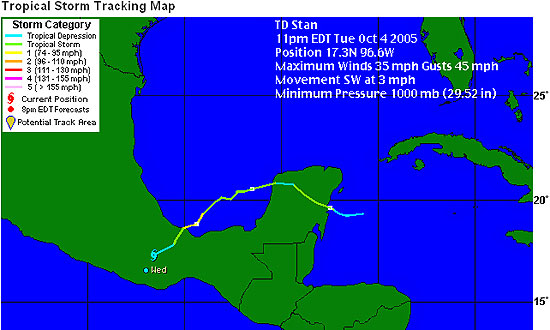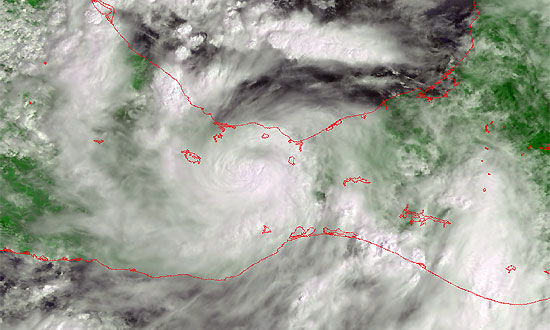|
Hurricane Stan (Mexico) - October 2005
VERACRUZ, 2005 October 04 (From CNN) - Hurricane Stan slammed into Mexico's Gulf coast Tuesday, forcing authorities to close one of the nation's busiest ports and spawning related storms across the region that left at least 66 people dead, most from landslides in El Salvador. The storm, which included winds of 80 miles an hour before being downgraded to a tropical storm, came ashore along a sparsely populated stretch of coastline south of Veracruz, a busy port 296 kilometers east of Mexico City. The storm's outer bands swiped the city, knocking down trees, flooding low-lying neighborhoods and closing some highways, authorities said. State officials said seven people, including two children, were hurt. Most injuries were from falling trees or roofs that collapsed in the communities of Alvarado and Montepio, south of Veracruz and closer to where Stan came ashore. All three of Mexico's Gulf coast crude-oil loading ports were closed Tuesday as a precaution. The shutdowns weren't expected to affect oil prices. Forecasters said the hurricane spawned separate storms across Central America and southern Mexico, provoking flooding and landslides. Some 49 people had been killed during two days of flooding in El Salvador, Interior Secretary Rene Figueroa said Tuesday night. More than 16,700 people had been evacuated to 167 shelters set up all over the country, he said. Nine people died in Nicaragua, including six migrants believed to be Ecuadoreans killed in a boat wreck, civil defense official Maj. Porfirio Castrillo said. Four deaths were reported in Honduras and three in Guatemala. In Mexico's southernmost state of Chiapas, a river overflowed its banks and roared through the city of Tapachula, carrying with it ramshackle homes of wood and metal. Chiapas Gov. Pablo Salazar said four people were missing and could have been swept away. He said 600 families had been evacuated from homes around Tapachula, near the Guatemalan border. Three bridges in the area were destroyed by floodwater. "Sadly, we know it's going to keep raining," Salazar said. In Costa Rica, a 36-year-old woman was asleep early Tuesday when her home was buried by a landslide, killing her. Rain was still falling Tuesday in much of Central America, forcing thousands from their homes. Among those evacuated were residents of the Salvadoran neighborhood of Santa Tecla, just outside the nation's capital, where a strong earthquake caused a massive landslide in January 2001. Officials have worried the mountain running alongside the neighborhood might collapse again from heavy rains or another quake. Honduras said it would send aid to El Salvador, and Mexico also offered financial assistance. Late Tuesday, Salvadoran officials declared a state of public calamity, allowing the executive branch to use public funds for emergency response. Back in Mexico's Veracruz state, classes were canceled and officials at a nearby nuclear power plant had readied the facility for strong wind and rain. Some 38,000 people abandoned their homes statewide, heading for thousands of shelters set up all along the coast and further inland. At Chachalacas beach, 32 kilometers north of the city of Veracruz, restaurant owner Celestino Criollo struggled amid rising wind and intermittent rain to clear equipment from his beach side, thatched-roof seafood restaurant. Criollo said the storm's rapid approach had caught many beach dwellers by surprise. "We knew it would be strong and the tide high, but we didn't think it would come this quick," he said. "They advised us, but they could have done it sooner."In the neighboring state of Oaxaca, which was also affected by heavy rain and wind, officials opened 950 shelters and were keeping an eye on 80 communities considered vulnerable. The closed crude-oil loading ports - Coatzacoalcos, Dos Bocas and Cayo Arcas - handle most of the 1.8 million barrels a day of crude oil exported by state-owned oil monopoly Petroleos Mexicanos, or Pemex. Five exploratory oil platforms also were evacuated Monday, but so far the storm hadn't affected the company's production of 3.4 million barrels a day of crude oil, Mexico's Communications and Transportation Department said. Pemex is the world's third-largest oil producer, and most of its exports are sent to the United States. VERACRUZ, 2005 October 04 (From CNN) - The official death toll from massive floods ravaging Central America and Mexico has surged to 763 as hundreds more were feared dead in Guatemala Monday, following last week's mudslide that swallowed two small towns in the west of the country. Hugo Hernandez, secretary of the Guatemalan National Disaster Relief Committee, said late Sunday the number of dead in his country had risen from 519 to 652 as emergency workers made their way to about 100 remote communities previously cut off by the disaster. In addition, 72 people were listed dead in El Salvador, 28 in Mexico and 11 in Nicaragua. But the death toll was likely to double as about 1,400 people were believed to have been buried alive by a mudslide that hit the Guatemalan towns of Panajab and Tzanchaj, 180 kilometers west of the Guatemalan capital, before dawn Wednesday. Diego Mendoza, mayor of the nearby community of Santiago Atitlan, asked Sunday that a river of mud that buried two Guatemalan towns be declared a mass grave for the thousands of people underneath. "It is now a cemetery for 1,400 persons, we reckon," Mayor Diego Mendoza told AFP. Only 71 bodies, mostly children, have been recovered in the mudslide-hit area hit by the mudslide so far. The corpses were placed in makeshift wooden coffins and quickly buried. "The size of the disaster is enormous," Guatemalan Vice President Eduardo Stein told Sonora radio. Stein said 130,000 persons were directly affected by Tropical Storm Stan. However, he said that 3.5 million people have been affected in areas where water and electricity have been cut. In this region of Guatemala, popular with tourists, rescuers armed only with shovels, picks and hoes to dig out the dead -- began showing signs of fatigue, as there was little food and drinking water in the devastated Lake Atitlan area. Rain fell across the country Sunday, complicating the recovery efforts as helicopters were unable to fly over devastated areas, officials said. Stan slammed ashore as a hurricane in the Mexican state of Veracruz early Tuesday but began pounding northern Central America with rain on October 1, with Guatemala taking the hardest blow. Guatemalan President Oscar Berger has made an impassioned plea for international assistance, estimating agricultural losses at 135 million dollars. But he did not hold out much hope for his compatriots. "I believe we are in for more unpleasant surprises," Berger said. "Many people remain missing. There have been many mudslides, and many communities remain cut off." Infrastructure and housing minister Eduardo Castillo said more than half of Guatemala's 10,000 kilometers of rural roads had been damaged. Twelve key bridges across the country were destroyed and another six seriously damaged. Nearly 1,300 homes were completely wiped out and more than 5,200 damaged. The United States, Japan, Mexico, Spain, Cuba, Canada and the Central American Bank for Economic Integration have pledged help. Norway's Ambassador Rolf Berg requested a detailed needs assessment to determine how best to help Guatemalans affected by the storm. Cuba sent 100 doctors to administer vaccines in El Salvador, earning the thanks of President Antonio Saco. Mexico has set aside 1.6 million dollars for rescue and reconstruction efforts from the recent spike in oil revenues and the country's emergency fund. Normally, when there are natural disasters, the Mexican army moves in to help. But Chiapas residents complained bitterly of being forgotten this time around. Hundreds walked from their village homes in search of drinkable water and food. Locals helped one another abseil down ravines and riverbeds where washed-out bridges used to be, trying to get into the nearest town. "The police don't want to get their shoes wet; they have left us to fend for ourselves," said Amado Montes, a resident of a village cut off by the flooding and mudslides.
This Medium Resolution Imaging Spectrometer (MERIS) image was acquired on 08 October 2005 over the Pacific Ocean coasts. This image shows Hurricane Stan (centre lower image) along the coasts of Guatemala and Honduras.
This Medium Resolution Imaging Spectrometer (MERIS) image shows Hurricane Stan as it slammed into Mexico's Gulf coast. The coastlines have been highlighted red to define their locations.
|
Related Links
|
|||||||||||||||||||||||||||||||||||||||||





